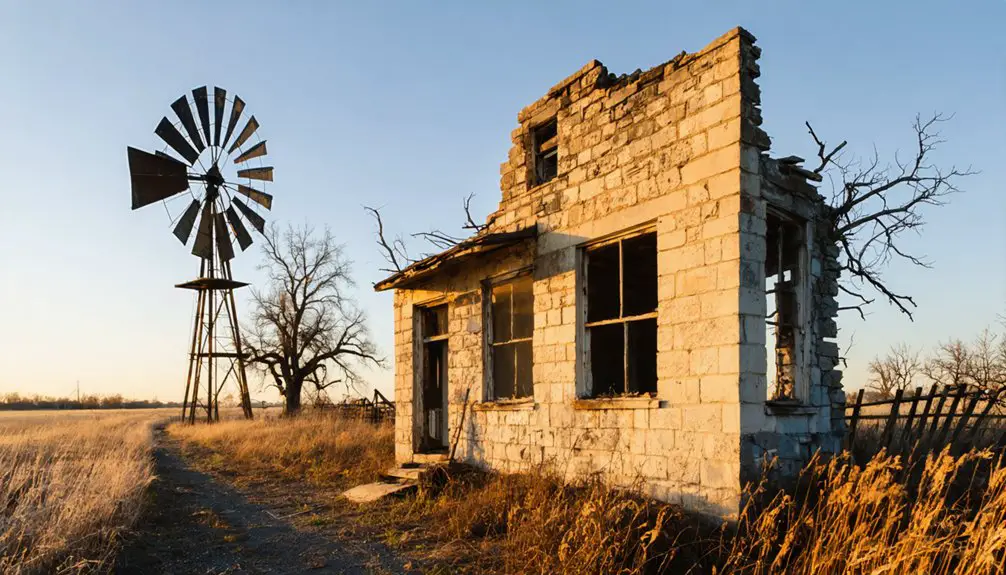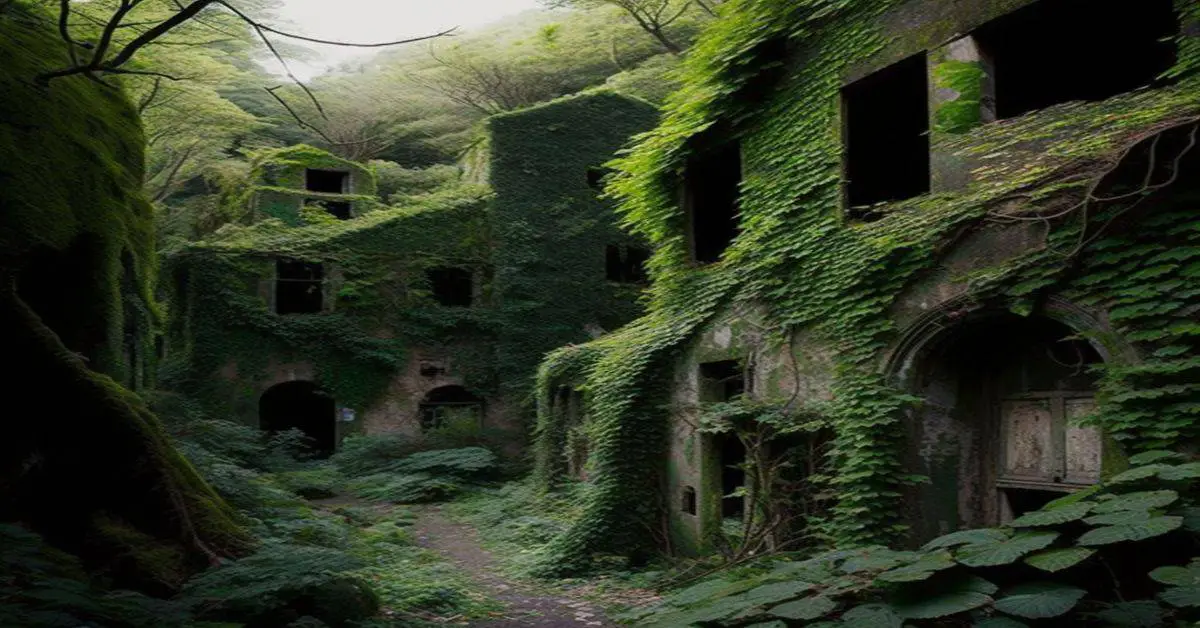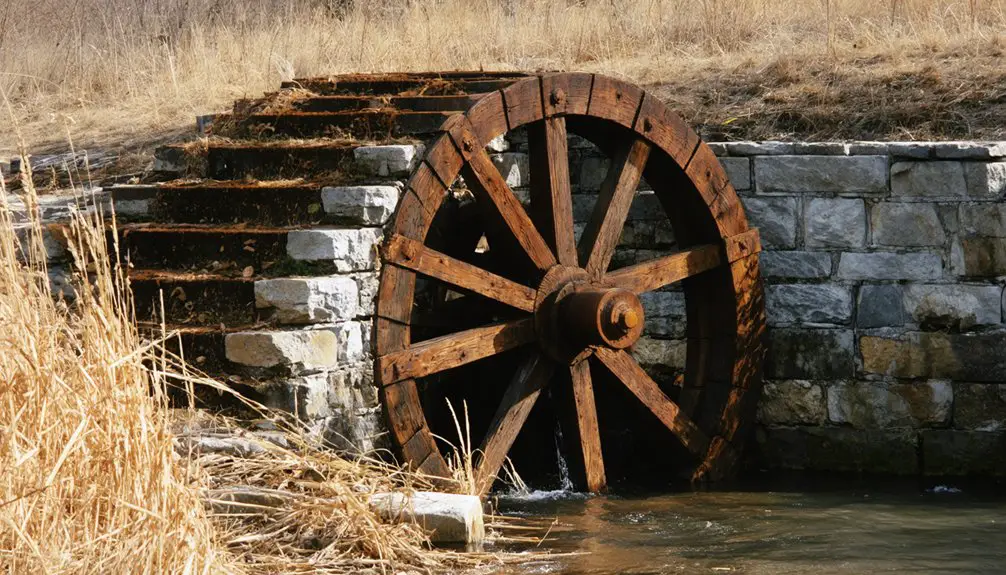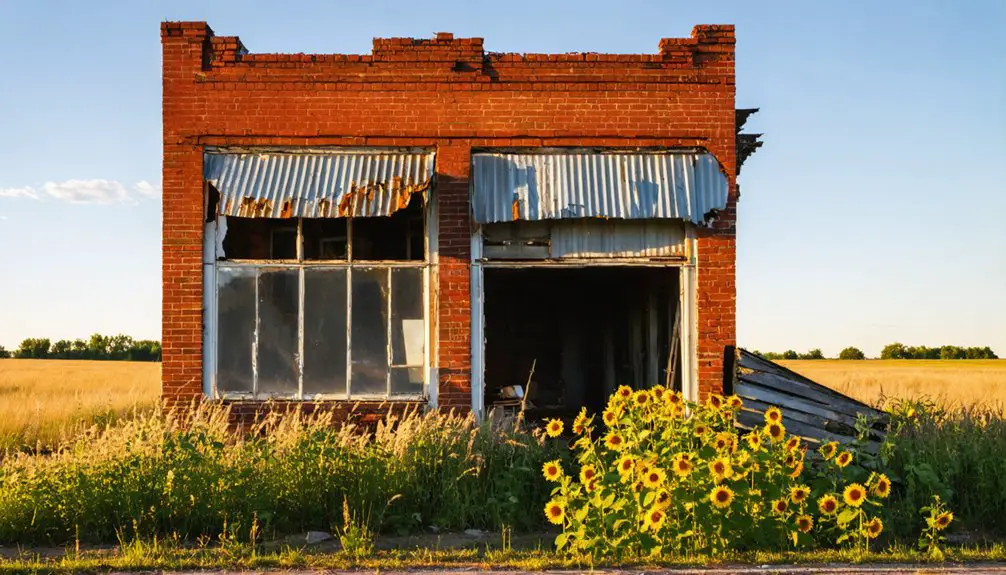You’ll find Neosho Falls in Woodson County, Kansas, where pioneers established a thriving settlement in 1857. As the county’s first seat, it grew to 1,200 residents with schools, banks, and the Santa Fe Railroad. The town’s decline began during the Great Depression, accelerated by the railroad’s departure in 1935, and culminated with devastating floods in 1951. Today, with just 140 residents, abandoned buildings and overgrown ruins tell stories of its pioneering past.
Key Takeaways
- Once-thriving county seat of Woodson County founded in 1857, now reduced to 140 residents from its peak of 1,200.
- Devastating 1951 flood destroyed homes and infrastructure, causing mass exodus and accelerating the town’s decline.
- Historic buildings, including the concrete Neosho Falls School and 1862 Snow Family Home, stand abandoned and deteriorating.
- Loss of railroad service, bank closures, and school shutdowns throughout the 20th century contributed to the town’s ghost status.
- Residents face extreme isolation with no businesses, emergency services, or reliable modern communications infrastructure.
The Rise of a Pioneering Settlement (1857-1925)
When National S. Goss and his fellow pioneers established Neosho Falls in 1857, they embodied the pioneering spirit that would transform this Kansas territory.
Despite restrictions protecting New York Indian lands, settlers like E. Fender and Judge John Woolman built the first cabins near the Neosho River, facing early challenges with determination.
You’ll find that Neosho Falls quickly became the heart of Woodson County, serving as its first county seat. The town’s strategic location and the construction of a dam across the river’s rapids attracted more settlers. The establishment of the first post office in 1858 marked a significant milestone in the town’s development. The town’s growth continued until the Great Depression struck, forcing its bank and newspaper to close.
Natural Disaster and Economic Downfall
While Neosho Falls had flourished through the late 1800s, a series of devastating events in the mid-20th century would spell its downfall.
The Great Depression struck first, shuttering the town’s newspaper and a key bank while driving away businesses and residents. You’d have seen further decline in 1935 when the Santa Fe Railroad abandoned its local operations, severing crucial trade connections. The high school closed in the 1960s, marking another step in the town’s decline.
Though a 1937 oil discovery sparked hope, economic resilience proved elusive as mechanization reduced job opportunities. The town that once boasted two major hotels and multiple mills could no longer sustain its commercial vitality.
The crushing blow came in 1951 when catastrophic flooding destroyed homes, businesses, and infrastructure. The flood aftermath proved insurmountable – recovery efforts fell short, accelerating the exodus of residents.
Architectural Legacy in Ruins
Today’s visitors to Neosho Falls encounter a haunting architectural legacy scattered throughout the semi-ghost town.
You’ll find the massive concrete Neosho Falls School, now shrouded in vines, standing as a representation of the town’s former liveliness. The Snow Family Home, dating back to 1862, reveals the architectural significance of early settlement despite its current state of elegant decay. During its peak, business districts flourished with hotels and merchants lining the bustling streets.
The town’s architectural heritage faces serious preservation challenges. Once-proud structures, including the historic post office established in 1857, now succumb to nature’s reclamation. The school, built in an Art-Deco style in 1939, exemplifies the town’s architectural ambitions during its oil boom years.
Graffiti marks many abandoned buildings, while others slowly crumble without maintenance. Despite these conditions, these architectural ruins continue to draw tourists interested in exploring the remnants of what was once the county seat of Woodson County, offering glimpses into Kansas’s pioneer past.
Notable Residents and Cultural Heritage
Three pioneering figures established Neosho Falls on April 6, 1857: Benjamin F. Goss, his brother Colonel National S. Goss, and Isaac W. Dow from Iowa.
The town quickly attracted influential residents, including the Snow Family, whose legacy shaped the cultural landscape. Maj. George Catlin Snow, known as “Big Father,” served as an Indian agent, while his daughter Florence became a distinguished writer and poet.
- The Snow Family’s home and “Fair Havens” hosted notable guests like Todd Lincoln, establishing the town as a cultural hub.
- Early institutions, including banks, hotels, and churches, created a thriving community center.
- Literary contributions, particularly Florence Snow’s autobiography “Pictures on my Wall,” preserved the town’s pioneering spirit.
You’ll find the cultural contributions of these notable residents woven into the very fabric of Neosho Falls’ history.
Present-Day Ghost Town Life
Despite its rich historical legacy, modern Neosho Falls stands as a shadow of its former self with only 140 residents, down from its peak population of 1,200.
You’ll find a community showing remarkable resilience despite profound rural isolation – there’s no police station, fire department, or even basic amenities like a gas station or grocery store.
The town’s last business, the Oasis Tavern, has shuttered its doors, leaving residents to travel to neighboring towns for essentials.
While cell service and satellite connections are weak or nonexistent, the community maintains its spirit through informal gatherings and country drives.
You’ll discover locals living a quiet but connected life, making do without emergency services or modern infrastructure, proving that even in ghost town conditions, determined residents can preserve their unique way of life.
Frequently Asked Questions
Are There Any Paranormal Activities Reported in the Abandoned Buildings?
You won’t find any documented ghost sightings or unexplained noises here. While those decaying buildings might look super spooky, there’s zero evidence of actual paranormal activity in these abandoned structures.
Can Visitors Legally Explore and Photograph the Ruins Today?
You’ll need explicit permission from property owners for legal ghost town exploration, as most structures are privately owned. Photography is allowed from public roads, but don’t enter buildings without authorization.
What Happened to the Original Town Records and Historical Documents?
Like autumn leaves scattered by storms, the town’s missing documents were lost to floods in 1926 and 1951, while others vanished during the Great Depression when local institutions failed to preserve historical significance.
Do Any Businesses Still Operate in Neosho Falls?
You’ll find a tavern, post office, and active oil operations sustaining the local economy today, though it’s a stark contrast to the town’s historical significance when railroads, mills, and banks thrived.
Is the Old Hydroelectric Dam Still Visible Along the River?
Like a silent sentinel carved from time, you’ll find the old hydroelectric dam still standing and visible today, creating a constant cascade of falling water you can spot during river exploration.
References
- https://legendsofkansas.com/neosho-falls-kansas/
- https://www.sekhistory.com/the-snow-family-a-home-for-snow-without-winter/
- https://architecturalafterlife.com/2015/05/neosho-falls-a-town-one-might-only-imagine/
- https://integratedskillsgroup.com/2021/06/neosho-falls/
- https://abandonedks.com/neosho-falls-school/
- https://en.wikipedia.org/wiki/Neosho_Falls
- https://traversingtravy.com/2012/03/11/exploring-neosho-falls-ks/
- http://www.kancoll.org/books/cutler/woodson/woodson-co-p1.html
- https://www.onlyinyourstate.com/experiences/kansas/neosho-falls-ghost-town-ks
- https://farmerdays.com/2016/07/20/neosho-falls-ks/



